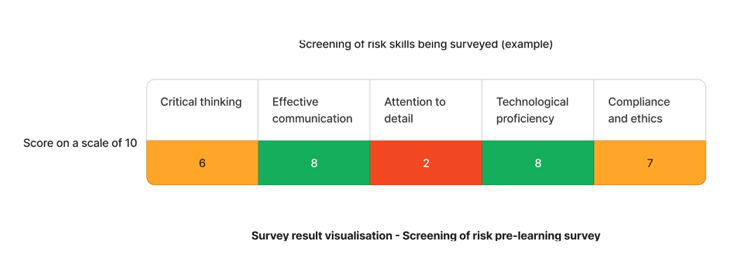The concept of "Screening of Risk" is a cornerstone in safeguarding the quality of healthcare in Australia. Established by the National Safety and Quality Health Service (NSQHS) - Action 5.10, Aged Care Quality Standards - Requirement 2.3(a), and Strengthened Aged Care Standards - Action 5.2.3, it is imperative for healthcare organisations to stringently follow risk screening processes to ensure optimal patient outcomes.
What is Screening of Risk?
Screening of Risk refers to the systematic evaluation of potential hazards, risks, or harm that could negatively impact patient safety or the quality of healthcare provided. This is accomplished by healthcare professionals through the use of specific tools, assessment protocols, and best-practice guidelines.
What is the Screening of Risk Training Requirement?
Training in Screening of Risk is a mandated criterion under several Australian healthcare quality standards. The training is not just confined to medical practitioners but extends to include all healthcare staff. Those involved in aged care, public and private hospitals, and disability care sectors must be proficient in various aspects of risk screening.
Relevant Standards
Action 5.10: Risk screening processes
Key tasks:
- Integrate screening processes into workflows with support from clinicians
- Produce information to include in; staff oreintation, education, and training programs about screening of risk
- Create strategies, frameworks and processes to provide feedback about efficiency and effectiveness of clinician risk screening
National Safety and Quality Health Service (NSQHS) Standards
Requirement 2.3 (a): Assessment and planning - screening of risk:
- Planning and assessment includes consideration of risks to consumer's health, safety, and wellbeing.
Action 5.2.3: Infection risk screening
Infection prevention systems include:
- a. Screening for risk-based vaccine preventable diseases (including immunisation for older people and the workforce)
- b. Disease risk screening and immunisation requirements for visitors
Strengthened Quality Standards framework analysis - Aged Care Quality Standards
Failure to comply with the requirements could lead to an organisation being penalised or reprimanded.
Related Training Requirements
The following Training Requirement guides can be used to support the risk screening training requirement (and may have some overlap).
What Skills Do Healthcare Staff Need for Risk Screening?
Proficiency in risk screening necessitates a multitude of skills. These skills are vital to ensure effective implementation and sustainability of risk management systems within healthcare settings:
| Skill | Key Elements |
|---|---|
| Critical Thinking | Healthcare professionals must be capable of evaluating situations to identify any risks that could potentially affect patient care. Critical thinking also entails the ability to prioritise risks based on their level of severity. |
| Effective Communication | Once risks are identified, staff must competently communicate their findings to relevant team members. This ensures collective awareness and collaborative decision-making. |
| Attention to Detail | A high degree of attention is necessary for accurately conducting risk assessments. A small oversight can lead to a major lapse in patient safety. |
| Technological Proficiency | Familiarity with electronic health records and risk management software is often essential for streamlining the screening process. |
| Compliance and Ethics | Staff should be well-versed in legal and ethical considerations surrounding risk management, as non-compliance can have severe ramifications. |
How to Assess Staff Competency in Risk Screening
Assessing competency in risk screening is a complex process and should be multi-faceted to capture the full scope of an individual’s skills. Several assessment tools and methods can be employed:
- Competency Checklists: A well-structured checklist can be used to assess a staff member's proficiency in specific skills related to risk screening.
- Direct Observations: Supervisors or senior healthcare professionals can directly observe staff during the risk screening process to gauge their competency.
- Scenario-Based Assessments: Staff could be presented with hypothetical situations, requiring them to identify and manage risks, thereby showcasing their practical understanding.
- 360-degree Feedback: Collected from peers, subordinates, and supervisors, this form of feedback offers a holistic view of an individual’s competency.
Strategies to Support Healthcare Staff Develop Skills in Screening of Risk
Given the essential nature of risk screening, strategies to bolster skills development in this area are paramount:
- On-the-job Training: Practical, real-world experiences often provide the best learning opportunities. Mentorship from experienced staff can enhance these learning experiences.
- Simulation Exercises: Simulated environments offer a risk-free space for staff to practice and refine their skills.
- Peer Reviews: Sharing best practices and lessons learned through peer reviews can foster a culture of continuous improvement.
- Online Modules: E-learning courses can be used to offer flexible training options, allowing staff to learn at their own pace.
Sample Training Plan for the Screening of Risk Requirement
Ensuring staff are competent in the relevant risk screening skills is essential to facilitate improved patient and client outcomes.

Using the above survey as an example - The skills that requires the most attention are attention to details skills. We can target learning initiatives to fill these gaps to enhance staff competency.
| Quarter | Topics | Resources |
|---|---|---|
| Q1 | Attention to details |
|
Need an LMS that can support screening of risk learning?
Contact Ausmed today and see how we can support with your risk screening requirements!
Staff Competency Assessment for Screening of Risk - Example
The following is an example survey that learning and development coordinators may use to asses staff competency on screening of risk to facilitate training plan development to their organisation's needs:
Staff Survey - Risk Screening Competency
-
Do you feel confident in your ability to identify risks during patient care?
- Yes
- Somewhat
- No
-
Can you name at least three tools used for risk screening?
- [Answer here]
- [Answer here]
- [Answer here]
-
How would you communicate a newly identified risk to your team?
- [Answer here]
-
What steps are involved in sterilising equipment?
- [Answer here]
-
How often do you review updated guidelines related to risk screening?
- 1. Not often at all
- 2. Somewhat often
- 3. Often
- 4. Vey often
-
Have you participated in any additional training for risk screening?
- Yes
- Somewhat
- No
Conclusion
Effective "Screening of Risk" is pivotal in elevating healthcare standards and safeguarding patient welfare. By instilling a comprehensive set of skills in staff and using robust methods for competency assessment, healthcare organisations can optimise their risk management strategies, ultimately enhancing the quality of care.
References
- Australian Commission on Safety and Quality in Health Care, 2023. 'NSQHS Comprehensive Care Standard'
- Australian Commission on Safety and Quality in Health Care, 2023. NSQHS Action 5.10
- Aged Care Quality and Safety Commission, 2023. 'Aged Care Quality Standard - Personal and clinical care - 3.3 (g)'
- Aged Care Quality and Safety Commission, 2023. 'Stronger Standards, Better Aged Care Program - 4.2.1-4.2.2'



